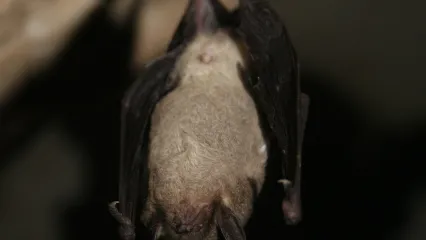
Description
The gray bat is a medium-sized bat, approximately 3.5 inches long with a wingspan of 11-13 inches. It weighs about half an ounce. This bat can be found in the same areas as other Myotis, but is distinguished by the uniformly- colored hair shafts that range in color from gray to reddish-brown.
Size
Its body is approximately 3.5 inches in length and its wingspan is 11-13 inches.
Habitat
Gray bats are reliant on limestone cave systems and are found in oak-hickory forests in the Ozark highlands. This species typically selects caves near water that contain domed ceilings for maternity sites, as these areas will allow for colonies to most efficiently trap heat for the rearing of pups. To date, all caves with gray bats in the state have been used as both maternity sites and summer roosts; however, no hibernation colonies have ever been documented. Nine gray bat maternity sites are known in Oklahoma; sites have been found in Adair, Delaware, Ottawa, and Cherokee counties. While a few individuals may overwinter in Oklahoma, the majority of gray bats migrate to caves in Arkansas and Missouri to hibernate.
Life Cycle
Gray bats use caves year-round for both raising young (maternity sites) and hibernation (hibernacula). They feed primarily on insects that have an aquatic larval stage, such as stoneflies, caddisflies, and mayflies. As such, maternity sites are often located within 3 miles of a large lake or river. Gray bats mate in the fall. After arousing from hibernation in early spring, females give birth to a single pup in late May or early June. Maternity colonies can number from a few hundred to several thousand individuals.
Since gray bats only use caves with certain characteristics, their habitat is naturally restricted. In fact, less than five percent of all caves in the entire range are suitable for gray bats. These bats also have a tendency to select caves along waterways, many of which are prone to submersion by flood events. As with other cave-dependent bats, gray bats are sensitive to disturbance during both pup-rearing and hibernation periods. Human visitation and vandalism of occupied caves is considered to be the primary factor in the decline for this species. White-nose syndrome, a disease that has caused widespread bat declines in eastern North America, has been detected on hibernating gray bats in Tennessee; however, the effects of the disease on the recovery of the species is unknown. Since 1993, the Wildlife Diversity Program has partnered with Rogers State University through ESA Section 6 funding to install protective steel gates and grills on the entrances of important caves used by both gray bats and Ozark big-eared bats. To date, entrances to at least seven of the nine Oklahoma gray bat maternity-use caves have been gated through this long-term collaboration. Post-construction monitoring has demonstrated that gates protect bat colonies by curbing unauthorized human entry. Another important component of gray bat recovery is ensuring the permanent protection of important caves through property acquisition. Through the ESA Section 6 Recovery Land Acquisition funding, the Wildlife Department has assisted the Oklahoma Chapter of The Nature Conservancy with important land purchases that have conservation benefit for this species.
How To Observe
For more information about this and other bats, download the free "Bats of Oklahoma Field Guide."


